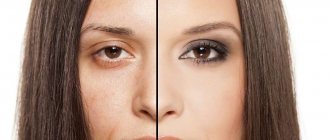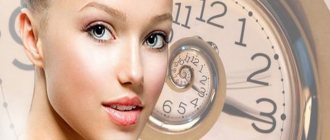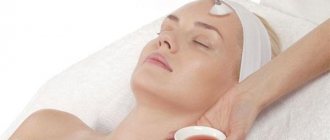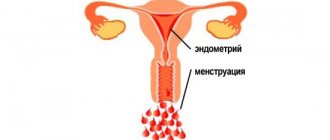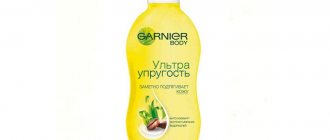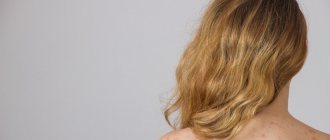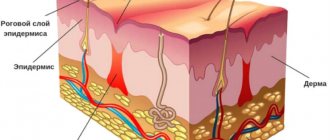Properly caring for the skin of your face and body is very difficult - especially during pregnancy. But the result of your own efforts will please any woman.
Oily skin is characterized by excessive secretion of the sebaceous glands. It is more resistant to low temperatures and wind, and undergoes aging processes more slowly. But under the influence of heat and high humidity, the advantages of oily skin turn into disadvantages: secretions clog pores and conditions are created for the proliferation of pathogenic microorganisms and the development of inflammation.
Problems with oily skin can be caused by other reasons. This includes eating large amounts of fats, carbohydrates, alcohol, spices, hormonal imbalance, and intestinal problems. Excess fat content may be a consequence of dysfunction of the nervous system, diseases of the endocrine glands, and the gastrointestinal tract. Pregnancy can also cause increased secretion of the sebaceous glands due to hormonal changes.
Back to contents
Skin care
Everyone knows that the skin of a pregnant woman’s face sometimes seems to glow from within. This is due to the fact that due to hormonal changes, more blood flows to the face and it looks refreshed. However, pregnant women also experience skin problems.
Age spots are a very common occurrence during this period. They can appear on the face, stomach and chest. As a rule, they go away within 4–5 months after the birth of the child.
However, to reduce their expression on the face, dermatologists strongly recommend using sunscreen with SPF of at least 30, and also not neglecting foundation - this will make you feel attractive and confident. By the way, BB and CC creams successfully combine the functions of moisturizing, sun protection and skin toning.
Acne - peeling and rashes on the skin of pregnant women - is associated with changes in the hormonal balance in the body. Skin may become drier, more sensitive and more prone to irritation. Don't worry, this is temporary.
- Use sun protection.
- Choose a new moisturizer for sensitive skin.
- Cleanse your skin with soft facial foams.
- Use anti-acne products, but first make sure that they do not contain substances that are not recommended for pregnant women.
Face during pregnancy
During pregnancy, a woman's body undergoes many changes. This is relevant not only for the internal organs and systems of a woman, but also for the skin, the condition of which especially changes in the second trimester.
As a rule, facial skin becomes oilier during pregnancy. This is due to the fact that a woman’s hormonal background changes, as well as the activation of the sebaceous and sweat glands. True, there is a category of expectant mothers who note that their skin has become drier with the onset of pregnancy.
Some women experience pigmentation of the skin on their face for 9 months. For example, chloasma (spots on the forehead, nose and cheeks) may appear. As a rule, in pregnant women with fair skin these spots are dark in color, while in dark-skinned women, on the contrary, they are light. After giving birth, everything will return to normal. In the meantime, try to spend less time in the open sun, since under the influence of ultraviolet rays the color of these spots may become more intense. Girls with freckles will have a brighter, “redder” face during pregnancy. Those with pale skin are least susceptible to pigmentation. But for brunettes and brown-haired women, the risk of having a “mask of pregnant women,” as facial pigmentation is called, is quite high. The reason for this phenomenon is also the increased effect on the body of sex hormones - estrogen and progesterone. When the baby is born and the hormonal levels level out, everything will return to its previous state.
During a healthy pregnancy, many women experience a blush on their cheeks. The reason for this phenomenon is the increased volume of blood, which actively flows through numerous blood vessels located under the skin.
During pregnancy, a woman may develop acne on her face. Do not try to take any medications for acne, they can harm your baby.
Take better care of your face with harmless hypoallergenic cosmetics and natural products, often used in home cosmetology. Acne may also appear due to hormonal changes. In this case, the woman needs the help of a dermatocosmetologist to prevent the appearance of scars.
More on the topic
Why do age spots appear on the face during pregnancy?
Acne during pregnancy
How to get rid of edema during pregnancy
Edema in late pregnancy
Why does pigmentation appear during pregnancy and how to deal with it?
Some pregnant women notice that they have hair on their face. There is no need to worry as most of this hair will also disappear after childbirth. The appearance of excessive hair is explained by accelerated blood flow and an increase in the amount of nutrients in the mother’s body, which causes improved nutrition of skin cells.
Facial swelling is common during pregnancy. The mechanism of edema is associated with changes in water-salt metabolism, as well as as a result of impaired outflow of blood and lymph through the veins of the legs and changes in the blood and vascular wall. If a woman’s face swells, then they speak of the third stage of edema. On the first, swelling is noted in the area of the feet and legs, on the second - on the lower extremities, lower abdomen and lumbosacral region, on the third, swelling on the arms is added, and a pasty “puffiness” appears on the face. The fourth stage is general swelling.
Swelling of the face is noticeable visually: it becomes rounder. In addition, you can independently determine whether there is swelling: press your finger on the skin, if there is a hole left, then most likely it is swelling. With such symptoms, you should immediately see a doctor. He will determine the exact cause of edema and prescribe adequate treatment. Inaction in this case can lead to serious problems. Most likely, in case of edema, the doctor will prescribe a dairy-vegetable diet for the pregnant woman, ask her to limit her intake of table salt, and, if necessary, prescribe medications.
And finally, I would like to note one more thing. Unfortunately, various signs regarding pregnancy are still relevant in everyday life. One of them says this: a pregnant woman should not touch her face, because the child will have many birthmarks. For some unknown reason, such nonsense was invented many years ago. And although there is no connection here, some people try to touch their face as little as possible. But is it really possible for 9 months without washing your face, scratching your nose, or, in general, never touching your face? And what is the connection between tactile contact to the mother’s face and the baby’s birthmarks? Therefore, be more reasonable and do not be influenced by unfounded prejudices.
Be healthy! Have a happy and beautiful pregnancy!
Especially for beremennost.net – Elena Kichak
What cosmetics are harmful for pregnant women?
Decorative cosmetics, as a rule, do not contain ingredients harmful to pregnant women. On the contrary, experimenting with makeup is a wonderful opportunity for pregnant women to take care of themselves and be positive.
With “care” products everything is different. Dermatologists recommend that during pregnancy you be attentive to what ingredients are in the creams, tonics and other cosmetics that a woman applies to her skin. The fact is that many substances can penetrate the skin and enter the bloodstream, which can potentially harm the child.
Here is a list of ingredients that are considered unsafe for pregnant women.
- Retinoids. They are usually added to anti-aging cosmetics. These are vitamins of group A, which accelerate the renewal of skin cells and prevent the breakdown of collagen, but they can harm the unborn baby if taken orally. Although there is no official data on the dangers of retinoids when used externally, doctors still recommend refraining from using cosmetics with this ingredient while expecting a child.
- Salicylic acid and BHA, one of its forms. It is used in a large number of cosmetics and is intended to treat acne. It also harms the unborn baby, primarily when taken orally. Doctors do not object to the external use of salicylic acid in creams or tonics - if its concentration does not exceed 2%. But if this additive is in scrubs and peels, salicylic acid penetrates deeper into the skin, and this is already considered unsafe for the baby.
- Soy. Products made from it are useful for pregnant women when added to the diet. How is soy harmful when used externally? Cosmetics based on this ingredient make age spots darker thanks to the phytoestrogens contained in soy. By the way, bergamot oil has the same effect.
Getting rid of acne during pregnancy?
- First of all, in the morning and evening, cleanse your skin using a special gel or foam for washing.
- A good helper is white, blue or green clay, masks from which should be made every 3-4 days. Clay perfectly absorbs sebum and draws out all impurities from the pores, and in addition, has an antibacterial effect. Dilute a small amount of clay purchased at a pharmacy with warm water to a paste and apply to the face for 20 minutes. Remove the mask with a damp cotton swab or pad and wipe your face with salicylic acid lotion.
- Fermented milk products will also help in the fight against rashes, preventing the spread of harmful microbes and soothing the skin. Try applying kefir or whey to your face for several days after each wash. 5 minutes is enough, after which moisturize the skin with your usual cream. Just remember, kefir must be natural, without any fruit additives or preservatives.
- For problem skin, a variety of yeast masks are also good. Yeast can be mixed with milk, mint infusion, or chamomile decoction. Mix the selected ingredients to obtain a homogeneous mass and apply the mask to your face. The mixture should be approximately body temperature. In 15-20 minutes the yeast will harden, so you can simply remove it from the skin with your hands (then you should still wash your face). Repeat the procedure once a week for several months, and the result will certainly not disappoint you.
- Finally, another recipe for a mask for problem skin: take half a glass of long grain rice, pour a glass of warm boiled water, cover and leave for 2 hours. After this time, drain the water, add 100 g of white cabbage, previously pureed, and mix thoroughly. This mask should be applied to the face in a thick layer and left for 15-20 minutes. The composition is washed off with cool water, after the procedure, as usual, the skin is lubricated with a moisturizer.
Dry skin in pregnant women
Many women during pregnancy complain of dry skin, flaking, and increased sensitivity. This phenomenon most often occurs in and is believed to be the result of a decrease in estrogen levels in the blood, which weakens the protective functions of the skin. To get rid of discomfort, you will have to regularly moisturize your skin, and one cream, alas, will not be enough.
- Of the variety of moisturizing masks, those based on vegetable oils deserve special attention. Olive oil has proven itself best, however, if you don’t have it on hand, regular sunflower or flaxseed oil will do. You can wipe the skin with oil after cleansing or, combining it with pureed vegetables, prepare special moisturizing compositions. An oil mask with mashed white cabbage will be good - the mixture is applied to the skin in a thick layer and left for 15-20 minutes. The yolk-chamomile mask also perfectly moisturizes: the yolk of 1 egg is thoroughly ground with 1 teaspoon of oil and 1 teaspoon of chamomile extract. The mixture is also applied for 15-20 minutes; it can be washed off with either water or, for example, the remaining chamomile infusion.
- A classic of the genre, a cucumber mask will also help your skin cope with dryness and flaking. You can simply put cucumber slices on your face and lie down for 20 minutes. Or experiment and, after grating the cucumber on a fine grater, add 1 tablespoon of sour cream. An excellent alternative to cucumber is chopped lettuce, rich in vitamins and beneficial microelements. As you yourself understand, all products must be fresh (those from the garden are ideal).
- Various masks with herbs - calendula, yarrow, coltsfoot - are also useful for dry skin. Herbal infusions can be purchased at the pharmacy. Grind them in a coffee grinder, mix, for example, with oatmeal (also crushed), add a couple of drops of vegetable oil and apply on your face for 15-20 minutes. You can also add sour cream, cottage cheese - in general, use your imagination to suit your taste. Just be careful, because herbal extracts cause an allergic reaction in some women. “Work” only with what is familiar to you and definitely will not cause harm.
Hair loss during pregnancy
During pregnancy, you can encounter not only skin problems, but also such an unpleasant phenomenon as hair loss. Don’t panic ahead of time - for most women, after giving birth, the process stops, and the hair takes on a healthy and attractive appearance. However, if you wish, you can carry out additional “therapy” for your hair - good care is always helpful.
- The simplest and most effective remedy that restores hair strength, elasticity and prevents hair loss is burdock oil, the healing properties of which have been known for a long time. Apply the oil at night and go to bed with a cap on your head. The next morning, after washing off the composition, you will see that your hair has become softer and shiny. To obtain maximum effect, the procedure will have to be repeated several times.
- A kefir mask is very common - it softens dry, coarse hair, and also heals the hair follicles. Apply the product to washed and wrung-out hair, distribute over the entire length and rub into the scalp in a circular motion, making a light wash. Then cover your head with cling film, wrap it in a soft towel and leave for 10-15 minutes. Rinse off the mask with warm water; there is no need to apply balm after it.
- Regular bread crumb also restores hair well. Crumble a couple of slices of rye bread, pour boiling water over it and let it brew for 5-10 minutes, then add 2 raw yolks. Apply the mixture to damp hair, rub well and cover with plastic. Keep the mask on for about half an hour. With regular use, it will accelerate hair growth and improve its quality.
- A cream mask is useful for strengthening hair: mix 2 tablespoons of fresh cream with 2 teaspoons of lemon juice, add 1 teaspoon of crushed wheat grains. The composition is applied for 20 minutes and washed off with water at room temperature. Sometimes crushed garlic is included in this recipe, but due to its specific smell, such a mask is not suitable for everyone. The same applies to onions - any strong-smelling ingredients are used only in the evening, and after using them it’s a good idea to spray your hair with an aromatic spray.
Sensitive skin in pregnant women
As you know, during pregnancy the sensitivity of the skin increases significantly, and therefore even the most innocent at first glance products can cause redness, itching and even swelling, in particular. In this regard, do not use potential allergens such as honey and strawberries for homemade masks; monitor the expiration dates of cottage cheese, eggs and other ingredients used. Do not overexpose the masks - most of them are applied for a maximum of 20 minutes. If you feel a strong burning sensation, wash off the composition without waiting for the specified time to expire. If your skin was especially tender and vulnerable before pregnancy, it makes sense to first try the mask on the back of your wrist or on the crook of your elbow. Did your skin react normally? In this case, feel free to apply the drug to your face. If irritation appears or a feeling of tightness occurs, do not experiment and choose another remedy.
Clay is an excellent antiseptic. It has anti-inflammatory, stimulating and regenerating properties. Clay is able to absorb fats and liquids and perfectly eliminates skin imperfections. It comes in white, blue, green, pink, red, grey, yellow and even black. Each variety has its own special properties.
For example, white clay has regenerating properties, improves complexion, and also perfectly fights acne. Blue clay is a storehouse of anti-inflammatory properties. In addition, it fights cellulite.
Green clay is excellent for deep cleansing, and also regenerates and nourishes the skin, tightens enlarged pores. Green clay can restore facial contours and tighten skin.
Pink clay strengthens nails, and gray clay perfectly moisturizes the skin. Red clay is indispensable for sensitive and prone skin.
Yellow clay has anti-acne and exfoliating properties. Black clay fights toxins in the body, which is why it is often used for body wraps.
How to deal with stretch marks
Is it possible to prevent stretch marks during pregnancy? Dermatologists say that genetic predisposition plays a key role here, and about half of women observe the appearance of stretch marks while expecting a child - on the stomach, chest, buttocks and thighs. Even special creams against the appearance of stretch marks will not protect against them. If women in your family have them on the skin, then you are not immune from their appearance. Here are the factors that can increase the likelihood of stretch marks:
- multiple pregnancy;
- rapid weight gain;
- you are carrying a large baby;
- you have excess amniotic fluid.
Dermatologists still recommend preventive measures:
- taking a contrast shower with simultaneous massage with a hard washcloth, you can use scrubs;
- daily moisturizing of the skin with vegetable oil, milk or body cream.
You can also smear the oil on the expectant mother’s tummy, but no one can guarantee that there will be no stretch marks. Don’t get hung up on this: if they appear, their manifestations can be reduced.
Enzymes against hair
Enzyme hair removal is a relatively new method of getting rid of excess hair, which works by destroying hair follicles with enzymes (or enzymes) - protein substances that play the role of catalysts in biochemical reactions. As a rule, these are trypsin, papain and chymotrypsin - proteins that can disrupt the hair reproductive system. The enzymatic hair removal procedure also involves a thermal effect on the skin, which helps to expand the mouths of the hair follicles and activate the work of enzymes.
Enzyme hair removal is considered one of the safest, most comfortable and inexpensive hair removal procedures, but it is also contraindicated for pregnant women. Thus, unfortunately, none of the methods for radical removal of unwanted hair is suitable for expectant mothers.
Nails and hair during pregnancy
Great news: while expecting a baby, the expectant mother's nails become stronger, and her hair becomes shiny and thicker. Surprises are also possible: wavy hair can become straight, or vice versa.
- •\tIt is worth keeping in mind that the hair seems thick not because more hair has begun to grow, but because it is now falling out less. In normal life, on average, we lose about 100 hairs per day, and during pregnancy, the process of hair loss slows down significantly. After childbirth, the hair will return to its normal state.
- Many women are concerned about excess hair growth on the face and body - do not worry, this is temporary. Choose a hair removal method that is convenient for you. However, remember that depilatory creams are not considered completely safe for pregnant women.
- Also, you should not start using a home epilator if you have not had such experience before: as a rule, the number of ingrown hairs increases during pregnancy, and it is extremely difficult to deal with them, so it is better not to increase the likelihood of their occurrence.
Is it possible to dye your hair during pregnancy?
There is no scientific evidence confirming the dangers of using conventional paint with ammonia during pregnancy. However, it is recommended to temporarily switch to more gentle, possibly unstable, paints or coloring instead of classic coloring.
- During this period, you need to especially strictly follow the instructions for hair dyes - check them for allergenicity by applying a little dye to the skin and waiting the right time. Do not under any circumstances try to dye your eyebrows or eyelashes with hair dye: this is very dangerous and can lead to irreparable consequences, including blindness.
It is worth remembering that during this period it is not recommended to experiment with perm: firstly, the substances included in the special mixture may be unsafe for the child, and secondly, the hair does not behave as usual. The result may be unpredictable.
Diet and lifestyle
Caring for oily skin is not only about home and salon treatments. An important factor is also compliance with a special diet aimed at stabilizing the microflora and intestinal functions. Canned foods, coffee, chocolate, lemonade, alcohol, and spices are excluded from the diet. You should limit your consumption of sugar, honey, sweet fruit juices, fried foods, and fats. It is recommended to consume baked goods made from wholemeal flour, grains, potatoes, mineral waters, natural yoghurts and fresh vegetables, cheese, cottage cheese, sugar-free fruit juices, green tea, pumpkin seeds. It is also recommended to take courses of multivitamin preparations.
For oily skin, the use of foundation and powder should be limited, and prolonged exposure to the sun should be avoided.
Tatyana Nalivaiko, Cosmetologist, Tver Article provided by the magazine “9 months” N 01 2006
Breast care during pregnancy
As a rule, everyone is ready for the fact that during pregnancy the breasts become larger - on average by 1 - 2 sizes. Her weight increases, and the ligaments cannot cope with the increased load. After breastfeeding is completed, it may become larger or smaller, everything is individual.
But if its size cannot be influenced, then is it possible to prevent the change in shape? Also, many women note that during pregnancy and childbirth, the nipples become larger and darker. Breast sensitivity may change during this period. What to expect?
1. As for the nipples, their size may decrease after breastfeeding ends, they may become lighter, but in each case everything is individual. The sensitivity of the nipples, as a rule, returns to the state it was before pregnancy.
2. Experts say that it is impossible to prevent changes in breast shape. This is a natural phenomenon. Here are some remedies you can resort to to make your breasts firmer:
2.1.1. after consulting with a specialist, do planks and other special exercises - they affect the pectoral muscles, and not the breast tissue, but nevertheless they can have an effect;
2.1.2. breast massage combined with almond, coconut or olive oil will improve skin tone. You need to be careful not to massage the nipple area, so as not to stimulate the production of oxytocin, which can cause uterine tone. It is recommended to do it about three times a week;
2.1.3. good posture, which can be achieved through yoga and gymnastics - as a result, the shape of the breasts improves;
2.1.4. It is recommended to wear special underwear, first of all, for comfort - during pregnancy, the breasts increase in size and need additional support.
Heat rash and diaper rash
Miliaria and diaper rash can occur in a pregnant woman. Because during pregnancy the body’s work increases, including the sweat glands actively working.
Miliaria occurs due to clogged pores. In order to cope with it, it is necessary to empty the pores and cool the skin as often as possible. A pregnant woman's everyday clothes should be made of natural cotton fabrics, especially underwear. For areas of the skin where prickly heat occurs, it is necessary to arrange air baths as often as possible. The use of fatty creams is prohibited; they clog the pores very much.
Diaper rash most often occurs where the skin touches each other. It is necessary to monitor the hygiene of problem areas as carefully as possible and, after drying, treat the areas with powder or talcum powder.
In summer, the problem may worsen due to heat
Miliaria and diaper rash usually occur in the third trimester of pregnancy and begin to subside immediately after childbirth.
If there is any discomfort on the skin, it is worth discussing it with your doctor so that he can help you sort out the problem and prescribe the correct treatment. Then pregnancy will be easy and beautiful.
How to choose a bra during pregnancy
Doctors believe that there is no urgent need to use specialized underwear for pregnant women. The main thing is that it does not squeeze the chest.
- Breasts grow in the 1st and 2nd trimesters, only reaching the size that will remain during the feeding period by the 3rd.
- You can choose the same bras for pregnant and nursing women and immediately buy bras that need to be partially unfastened for breastfeeding.
- When choosing a bra, it is important to pay attention to the fabric composition: cotton and lycra are preferable. Such underwear stretches when necessary without causing discomfort. The straps should be wide and the cups should cover the entire chest. There is no need to choose bras with underwires: they can move and pinch the duct during breastfeeding.
- From the second trimester, colostrum may be released from the nipples - use special bra inserts.
- How many bras should you buy? As a rule, women during pregnancy and lactation need three special bras.
What will they offer in the beauty salon?
Beauty salons can also offer several programs to care for oily skin. As a rule, this is comprehensive care. First of all, it includes deep cleansing, carried out 2-3 times a week. This is a peeling that a cosmetologist selects depending on the condition of the skin. The purpose of peeling is to eliminate the thickening of the stratum corneum, the dead layer of the epidermis, and to facilitate the removal of comedones. When peeling the following can be used:
- enzymes (for example papain); with their help, dead scales of the epidermis dissolve;
- fruit acids;
- special foaming creams and scrubs for oily skin.
The next procedure is vaporization (cleansing the skin using a device that produces a jet of steam under pressure). The procedure is carried out in the absence of inflammatory elements on the skin. Vaporization softens the stratum corneum of the epidermis, which facilitates further mechanical cleaning.
Next, you can carry out brossage - removing what happened after peeling, using rotating brushes made of natural bristles of varying hardness.
Mechanical cleaning is performed using a special spoon or loop that captures and removes the core of the inflammatory element. Most often, it is impossible to remove all comedones at one time, so for the best effect and less trauma to the skin, 3-5 sessions are necessary.
An antiseptic, cooling, pigment-constricting mask will give the skin a matte appearance, soothe it (relieve redness and swelling), and prevent the appearance of new inflammatory elements.
Therapeutic massage will speed up the resorption of marks and inflammations. The treatment ends with the application of cream for oily skin.
Bandage during pregnancy
Many mothers feel the desire to wear a bandage: the load on the back and tailbone makes itself felt. However, doctors categorically do not recommend buying bandages and wearing them without good reason. And that's why:
- abdominal muscles do not strengthen and recover more slowly after childbirth;
- in the third trimester, the bandage may prevent the baby from taking the correct position before birth.
Typically, your doctor may recommend wearing a brace if you have severe back pain or multiple pregnancies. In any case, you need to make sure that this “wardrobe element” does not put pressure on your stomach or cause discomfort. As a rule, it is not recommended to sleep in it. In addition, you need to take breaks during the day - here you need to follow your doctor's recommendations.
We wish you a beautiful and comfortable pregnancy!
Toxicosis, varicose veins and other pregnancy problems
Such a problem as early toxicosis of pregnant women, especially if it is pronounced, also does not have the best effect on the condition of the skin of the expectant mother. Increased salivation and vomiting lead to dehydration (dehydration). The skin becomes thinner, acquires a grayish tint, sometimes with slight jaundice. Dark circles appear under the eyes because here the skin is thinnest and has no subcutaneous fat layer at all.
Due to poor appetite, the pregnant woman’s body does not receive enough necessary vitamins, which, in turn, also affects the condition of the skin and its appendages (hair, nails). Peeling, excessive dryness of the skin, cracks in the corners of the mouth (jams), irritation, increased sensitivity of the skin to ultraviolet radiation, itching, hair loss and brittle nails may appear.
With late toxicosis, fluid retention in the body and the appearance of edema come first. The skin becomes loose, “watery”, signs of cellulite appear, and if injured, infection of the injury site may develop, since immunity is reduced.
Many women, especially with repeated pregnancies, suffer from varicose veins - these include spider veins on the legs, unsightly protruding tortuous veins, and the same swelling.
A common problem can also be itchy skin, which worries a woman in the last months of pregnancy. It usually causes itching on the palms, feet, and abdominal area. In this case, no rashes are observed in the itching areas, but the itching itself can cause significant discomfort. In addition, scratches can become infected. This skin itching is associated with the fact that the expectant mother's liver works under increased load and produces substances that irritate skin receptors.


